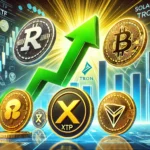A recent conversation involving Ripple’s current chief executive officer, Brad Garlinghouse, and Leemon Baird, founder of Hedera, has attracted the interest of XRP holders. It also shows that there may be opportunities for collaborating between their blockchains. The conversation shared by crypto influencer Amelie shows that there is a need for cooperation in the blockchain ecosystem, which could imply that partnerships would be sought between Ripple and Hedera.
Ripple and Hedera Advocate for Blockchain Synergy
During the exchange, Garlinghouse was positive about the possibility of working together with Hedera while building Ripple. He said: “We have a point of contact, and we can follow up with the Hedera community and work with them. And I think we haven’t yet come together around that, and I think there’s an opportunity to do that.” The same was true for Baird, who has always been an advocate for synergy in the industry.
He continued, “What we need to be doing is having the blockchains working together…. When we see scams, we call them out, let other exchanges know, and, as an industry, work. This is what’s hindering all of us.”

Both parties were receptive to the fact that dealing with some common issues, for instance, scams and public education, would be advantageous to their platforms and propel the growth of the blockchain industry as a whole. Such togetherness is seen in the context of a larger tendency of oneness in the industry, which is otherwise full of competition and tribalism.
Ripple and Hedera Tackle Tribalism to Build a Stronger Crypto Ecosystem
The conversation also revolved around a certain degree of tribalism in the cryptocurrency space. Garlinghouse and Baird remarked that some of the blockchain communities have always been at rival ends, which has prevented huge advancement. Nonetheless, both were optimistic that tribal tendencies were on the decline. Garlinghouse said: “If ever you were to chart out the impact that tribalism has had over time… I feel it is dying down in the industry where we operate.” Such a decline creates room for more cooperation and mutual development among the different blockchain projects.
Garlinghouse likewise mentioned the current problem of Ripple, which is entangled in the legal tug-of-war with the U.S. SEC. He added that the warfare is not simply for Ripple but for the entire cryptocurrency sector. This view is consistent with an increasing understanding among the leaders of the industry that there may be a need for industry mobilization to address regulatory difficulties.
Ripple and Hedera Explore Synergy to Address Industry Challenges
Ripple and Hedera have worked together on various projects before. In May 2024, they pledged to establish the DeRec Alliance, which focuses on enhancing the process of recovering digital assets in a decentralized manner, and they became its initial members. Besides, in September 2024, the two corporations also formed the MiCA Crypto Alliance in order to facilitate compliance with the regulations on virtual currencies set by the European Union.
Speculations Around Ripple, Hedera, and Goldman Sachs

There has been a conversation in the XRP circles, especially with the ongoing talks of a possible cooperation deal with Goldman Sachs. Recently, Shawn Oroogle, a participant of the World Economic Forum (WEF), gave hints that there are or could be interactions between XRP, Hedera (HBAR), and Goldman Sachs. Although these statements are yet to be proven, they have spurred a great deal of concern in the crypto domain.
Though there are persistent speculations about the relationship between Ripple, Hedera and Goldman Sachs, both companies have not announced any official engagements with the investment bank or any other party concerning new projects so far. Nevertheless, their previous partnerships indicate a tendency to support the development of blockchain technology.
Ripple and Hedera’s Collaboration Hints at a More Unified Crypto Future
While still in the talks of possible collaborations, Ripple and Hedera are already taking part in defining blockchain technology. Their willingness to work together may not only improve the services of each platform but also help with better integration of all platforms in the crypto space. As each of the two organizations faces its own issues – be it compliance with regulations or rivalry in the market – the chances of finding ways to work together are likely to bring about positive changes to this industry, which many players are still struggling to understand.










